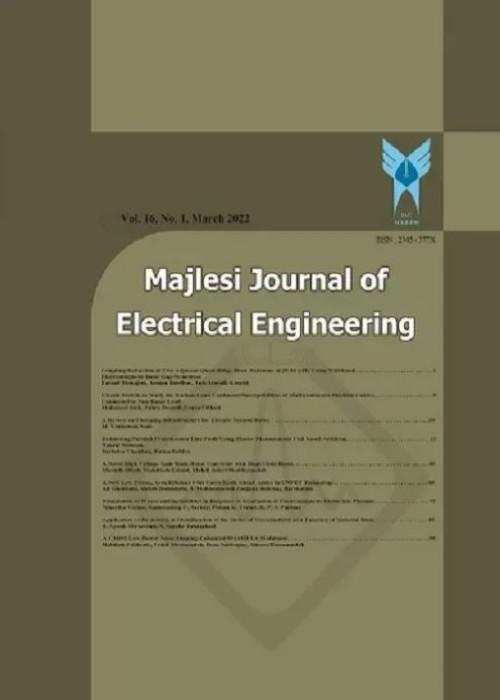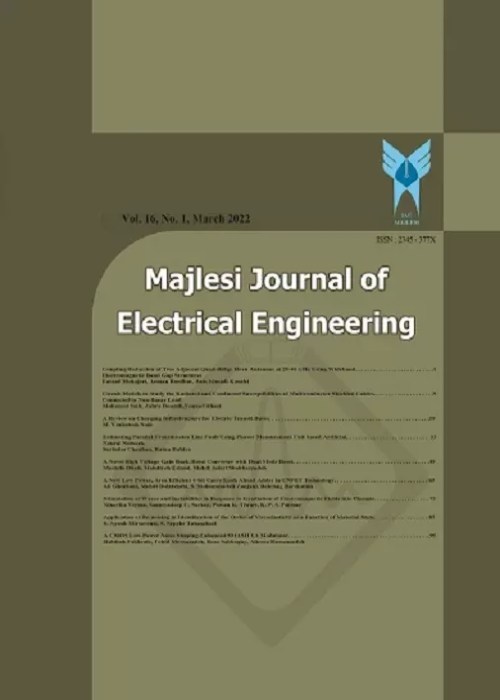فهرست مطالب

Majlesi Journal of Electrical Engineering
Volume:17 Issue: 1, Mar 2023
- تاریخ انتشار: 1402/02/12
- تعداد عناوین: 9
-
-
Pages 1-27
There is growing commitment to phase-out the conventional fossil-fuel based power stations to decentralized power generation with high share of renewable energy sources that is based on low-emission to meet the various techno-economic, environmental and secure energy requirements. This paradigm shift from conventional generators to the inverter-dominated DGs/RESs, has come with some technical challenges of low inertia, frequency instability, harmonic distortion etc. The challenges require effective and efficient inverter-based power system control for a reliable and stable grid interface. Based on the way inverters functions, it is grouped into three categories: grid-feeding, grid-supporting, and grid-forming. Several control schemes have been proposed for grid-forming inverter; these control schemes are based on the concept of Virtual synchronous machine, Power synchronization control, and Direct power control. This paper presents a comprehensive review on the recent advancements in grid-forming inverter control technologies. This review covers different control techniques that have been successfully implemented for the inverter-based power system to grid interface, benefits and challenges of attaining the estimated 100% non-synchronous power generation. The cornerstone of the survey is to also establish state-of-the-art on the grid-forming inverter and identify future research areas for improving the existing techniques and developing novel ones.
Keywords: Distributed Generation, Grid-forming, Power Synchronization Control, Renewable Energy Sources, Virtual Inertia -
Pages 29-54
In recent decades, network security has become increasingly crucial, and intrusion detection systems play a critical role in securing it. An intrusion Detection System (IDS) is a mechanism that protects the network from various possible intrusions by analyzing network traffic. It provides confidentiality and ensures the integrity and availability of data. Intrusion detection is a classification task that classifies network data into benign and attack by using various machine learning and deep learning models. It further develops a better potential solution for detecting intrusions across the network and mitigating the false alarm rate efficiently. This paper presents an overview of current machine learning (ML), deep learning (DL), and Explainable Artificial intelligence (XAI) techniques. Our findings provide helpful advice to researchers who are thinking about integrating ML and DL models into network intrusion detection. At the conclusion of this work, we outline various open challenges.
Keywords: Network Security, Intrusion Detection, IPS, Preprocessing, SMOTE, Datasets, Attacks, Feature Selection, XAI -
Pages 55-61
Short Term Load Forecasting (STLF) is the projection of system load demands for the next day or week. Because of its openness in modeling, simplicity of implementation, and improved performance, the ANN-based STLF model has gained traction. The neural model consists of weights whose optimal values are determined using various optimization approaches. This paper uses an Artificial Neural Network (ANN) trained using multiple hybrid techniques (HT) such as Back Propagation (BP), Cuckoo Search (CS) model, and Bat algorithm (BA) for load forecasting. Here, a thorough examination of the various strategies is taken to determine their scope and ability to produce results using different models in different settings. The simulation results show that the BA-BP model has less predicting error than other techniques. However, the Back Propagation model based on the Cuckoo Search method produces less inaccuracy, which is acceptable.
Keywords: Short Term Load Forecasting, Hybrid Techniques, Artificial Neural Network, Back Propagation, Cuckoo Search, Bat Algorithm -
Pages 63-74
In this article, asymmetrical modular multilevel converter (A-MMC) topology using mixed cell (SM) with DC-side fault blocking capability and the reduced component count is proposed. The mixed cell submodule is made up of a full-bridge (FB-SM) and a half-bridge (HB-SM) with asymmetric capacitor voltage based on geometric propagation (GP) ratio. Each mixed cell submodule can generate a maximum of four output voltage levels with binary GP ratio and five output voltage levels with ternary GP ratio using six controlled switches and two asymmetric capacitors. The proposed A-MMC topology requires nearly half the number of components and voltage sensors compared to conventional topologies. This will result in simpler control structure of A-MMC with DC fault blocking capability. A voltage balancing algorithm based on normalization is used for capacitor voltage balancing and a hybrid pulse width modulation (H-PWM) technique to generate gating signals. Detailed operational concepts of the proposed topology, the pre-charging process of a capacitor, and performance with different modulation indexes are discussed in length. A detailed simulation model of A-MMC under different operating conditions is carried out using MATLAB/SIMULINK environment. To show the benefits of mixed cell SM, a comparison between the proposed mixed cell and other existing cells is presented in detail. The simulation results analysis show effectiveness of proposed schemes over other schemes presented in literature.
Keywords: Asymmetrical Modular Multilevel Converter (A-MMC), HVDC System, Mixed Cell, Hybrid Modulation Technique, Reduced Component Count, DC Fault Blocking Capability -
Pages 75-80
Side-channel attacks are attacks against cryptographic devices that are based on information obtained by leakage into cryptographic algorithm hardware implementation rather than algorithm implementation. Power attacks are based on analyzing the power consumption of a corresponding input and obtaining access to this method. The power profile of the encryption circuit maintains an interaction with the input to be processed, allowing the attacker to guess the hidden secrets. In this work, we presented a novel architecture of masked logic cells that are resistant to power attacks and have reduced cell numbers. The presented masking cell reduces the relationship between the actual power and the mathematically approximated power model measured by the Pearson correlation coefficient. The security aspect of the logic cell is measured with the correlation coefficient of the person. The proposed mask-XOR and mask-AND cells are 0.0053 and 0.3respectively, much lower than the standard XOR and AND cells of 0.134 and 0.372, respectively.
Keywords: Side-Channel Attack, Power Attack, Mask Cell, Correlation, Data Hiding, Hardware Security -
Pages 81-96
Load frequency control is an important factor of supplying quality electricity in an interconnected power system. As a result, an optimally tuned Proportional-Integral-Derivative (PID) controller is proposed in this work to eliminate frequency errors caused by unexpected load changes while maintaining tie-line power exchange. The PID controller is tuned using several optimization techniques such as GA, PSO, SCA, and GWO. A two-area power system with Generation Rate Constraint is studied in the first instance, and a three-area thermal power system with both generation rate constraint and dead band effect is considered in the second case. In both scenarios, a PID controller is employed for each area. When compared to the results of other optimization approaches for the same integrated power system, such as Genetic Algorithm, Particle Swarm Optimization, and Sine Cosine Algorithm, the GWO-based PID controller outperforms them in both scenarios. According to the simulation findings, the GWO technique gives better dynamic responses in terms of overshoot value, settling time, and Integral Time Absolute Error. Finally, to evaluate the robustness of the suggested optimization strategies, sensitivity analysis is done by modifying the system parameters (turbine time constant, governor time constant, and both simultaneously) in the range of 25% from their nominal values.
Keywords: Load Frequency Control (LFC), PID Controller, Generation Rate Constraint, Frequency Deviation, Grey Wolf Optimization (GWO) -
Pages 97-108
In different medical applications, physical stimulation techniques are used to assist the treatment and improve the treatment conditions from different perspectives. They can accelerate the healing process and stimulate biological processes and healing mechanisms. In oral and maxillofacial reconstruction, one of the widely used physical stimulation techniques is Low-Level Laser Therapy (LLLT). LLLT is a photonic stimulation technique that accelerates the biological processes of the cells and healing mechanisms. In LLLT, light photons are used to physically impact the healing zone. Distraction Osteogenesis (DO) is a novel reconstruction technique that is used for tissue regeneration in different body zones. By using DO, acquired and congenital bone defects can be reconstructed. Recent experimental studies show that in a DO treatment, the application of LLLT during bone regeneration process can significantly improve the outcome of the treatment and enhance the quality of the regenerated bone tissue. In this research a LLLT device is proposed to be used during DO in maxillofacial reconstruction applications. The results of this study show that the proposed device can generate single- and multi-wavelength laser lights with controlled parameters. The proposed system can be used during the DO treatment to shorten the treatment time and improve the quality of the outcome and treatment conditions.
Keywords: Maxillofacial Reconstruction, Photonic Stimulation, Medical Device, Physical simulation, Distraction Osteogenesis -
Pages 109-115
During peak demand hours, hydroelectric energy is one of the most significant sources of energy. Power sector restructuring has increased competition among the country's electricity providers. Estimating the future price of energy is critical for producers in order to enhance investment profit and make better use of resources. One of the most significant technologies of artificial intelligence, Artificial Neural Networks (ANN), has various applications in estimating and forecasting phenomena. Combining artificial intelligence models with optimization models (e.g. Artificial Bee Colonoy [ABC]) has recently become quite popular for improving the performance of artificial intelligence models. The goal of this study is to look at the effectiveness of ANN and ABC-ANN models in forecasting the dispersed and sinusoidal data of Angola's daily peak power price. The findings reveal that in this case study, the employment of the ABC-ANN model is not superior to the ANN model and has not resulted in enhanced performance and forecasting of power market data. As a result, the R2 of the ANN and ABC-ANN models is 0.88 and 0.85, respectively.
Keywords: Artificial Neural Network, Artificial Bee Colony, Energy Cost, Optimization -
Pages 117-121
Dielectric Barrier Discharges (DBDs) are self-sustaining electrical discharges in electrode configurations containing an insulating material in the discharge path. Dielectric barrier discharge is considered a new method to produce plasma, which is of interest to researchers in various fields. In this article, electrical breakdown and plasma formation with argon atmospheric pressure gas are simulated. To avoid the complexity of the problem and faster convergence, the simulation has been done in one dimension. It has been shown that the optimization of a plasma reactor depends on the distance between the electrodes and the gas flow rate. By changing different discharge gaps, the gap has been optimized and as a result, optimized power consumption has been achieved.
Keywords: Dielectric Barrier Discharge, Plasma, Power Systems, Finite Element Method, Ionisation


